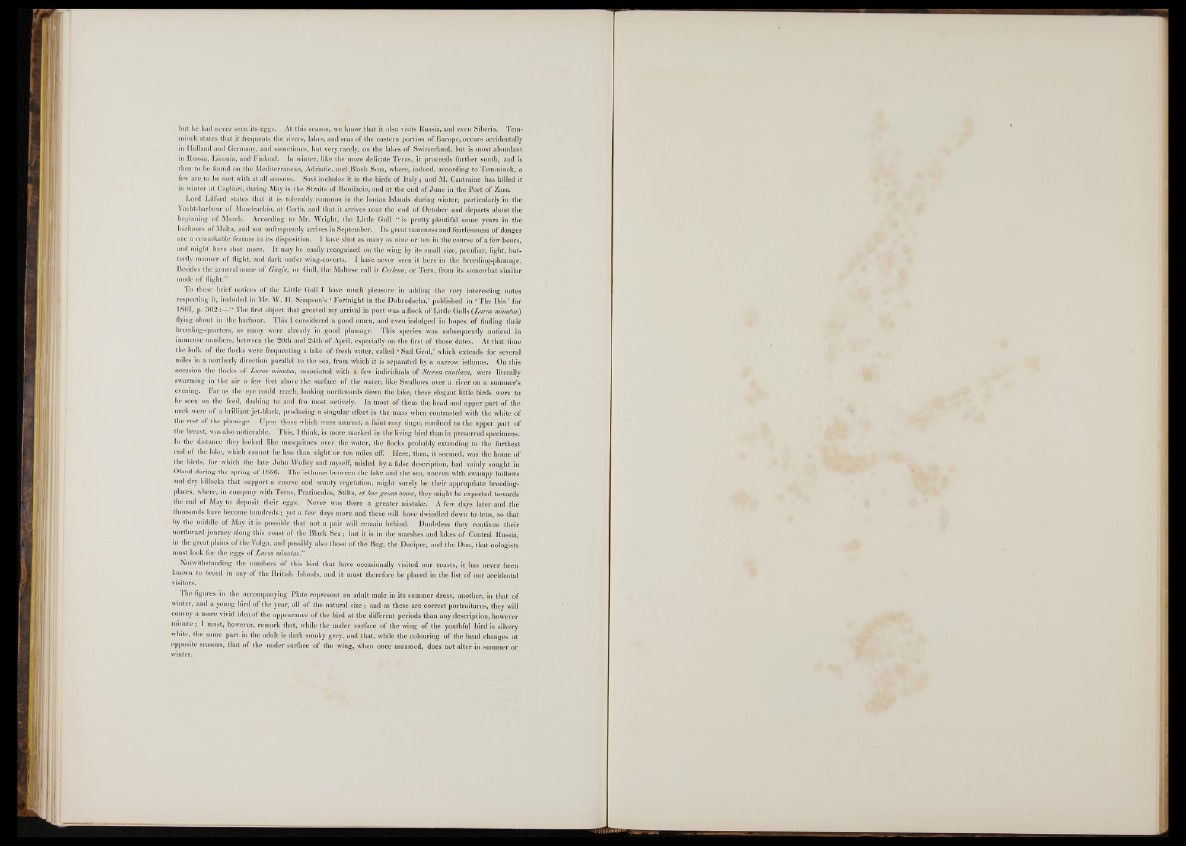
but lie bad never seen its eggs. At this season, we know that it also visits Russia, and even Siberia. Tem-
minck states that it frequents the rivers, lakes, and seas of the eastern portion of Europe, occurs accidentally
in Holland and Germany, and sometimes, but very rarely, on the lakes o f Switzerland, but is most abundant
in Russia, Livonia, and Finland. In winter, like the more delicate Terns, it proceeds further south, and is
then to be found on the Mediterranean, Adriatic, and Black Seas, where, indeed, according to Temminck, a
few are to be met with at all seasons. Savi includes it in the birds o f Italy; and M. Cantraine has killed it
in winter at Cagliari, during May in the Straits of Bonifacio, and at the end o f June in the Port o f Zara.
Lord Lilford states that it is tolerably common in the Ionian Islands during winter, particularly in the
Yaeht-lmrbour of Mnndrachio, at Corfu, and that it arrives near the end of October and departs about the
beginning of March. According to Mr. Wright, the Little Gull “ is pretty plentiful some years in the
harbours o f Malta, and not unfrequently arrives in September. Its great tameness and fearlessness o f danger
are a remarkable feature in its disposition. I have shot as many as nine or ten in the course of a few hours,
and might have shot more. It may be easily recognized j>n the wing by its small size, peculiar, light, butterfly
manner o f flight, and dark under wing-coverts. I have never seen it here in the breeding-plumage.
Besides the general name o f Gauja, or Gull, the Maltese call it Cerleua, or Tern, from its somewhat similar
mode o f flight.”
To these brief notices of the Little Gull I have much pleasure in adding the very interesting notes
respecting it, included in Mr. W. H. Simpson’s ‘ Fortnight in the Dobrudscha,’ published in ‘ The Ibis ’ for
1861, p. 362 :—“ The first object that greeted my arrival in port was a flock o f Little Gulls (Larus minutus)
flying about in the harbour. This I considered a good omen, and even indulged in hopes df finding their
breeding-quarters, as many were already in good plumage. This species was subsequently noticed in
immense numbers, between the 20th and 24th of April, especially on the first of those dates. At that time
the bulk o f the flocks were frequenting a lake o f fresh water, called ‘ Sud Geul,’ which extends for several
miles in a northerly direction parallel to the sea, from which it is separated by a narrow isthmus. On this
occasion the flocks of Larus minutus, associated with a few individuals o f Sterna cantiaca, were literally
swarming in the air a few feet above the surface o f the water, like Swallows over a river on a summer’s
evening. Far as the eye could reach, looking northwards down the lake, these elegant little birds were to
be seen on the feed, dashing to and fro most actively. In most o f them the head and upper part o f the
neck were o f a brilliant jet-black, producing a singular effect in the mass when contrasted with the white of
the rest of the plumage. Upon those which were nearest, a faint rosy tinge, confined to the upper part of
the breast, was also noticeable. This, I think, is more marked in the living bird than in preserved specimens;
In the distance they looked like musquitoes over the water, the flocks probably extending to the furthest
end of the lake, which cannot be less than eight or ten miles off. Here, then, it seemed, was the home of
the birds, for which the late John Wolley and myself, misled by a false description, had vainly sought in
Oland during the spring o f 1856. The isthmus between the lake and the sea, uneven with swampy hollows
and dry hillocks that support a coarse and scanty vegetation, might surely be their appropriate breeding-
places, where, in company with Terns, Pratincoles, Stilts, et hoc genus omne, they might be expected towards
the end o f May to deposit their eggs. Never was there a greater mistake. A few days later and thé
thousands have become hundreds ; yet a few days more and these will have dwindled down to tens, so that
by the middle o f May it is possible that not a pair will remain behind. Doubtless they continue their
northward journey along this coast of the Black Sea ; but it is in the marshes and lakes of Central Russia,
in the great plains of the Volga, and possibly also those of the Bug, the Dneiper, and the Don, that oologists
must look for the eggs of Larus minutus
Notwithstanding the numbers of this bird that have occasionally visited our coasts, it has never been
known to breed in any o f the British Islands, and it must therefore be placed in the list o f our accidental
visitors.
The figures in the accompanying Plate represent an adult male in its summer dress, another, in that of
winter, and a young bird o f the year, all of the natural size ; and as these are correct portraitures, they will
convey a more vivid idea of the appearance o f the bird at the different periods than any description, however
minute ; I must, however, remark that, while the under surface o f the wing of the youthful bird is silvery
white, the same part in the adult is dark smoky grey, and that, while the colouring o f the head changes at
opposite seasons, that o f the under surface o f the wing, when once assumed, does not alter in summer or
winter. '